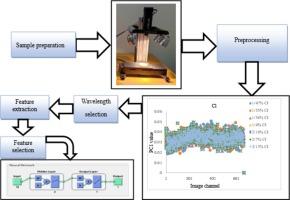利用化学成像和人工神经网络检测氯化钾和硫酸钾中的氯
IF 4.6
2区 化学
Q1 SPECTROSCOPY
Spectrochimica Acta Part A: Molecular and Biomolecular Spectroscopy
Pub Date : 2024-10-10
DOI:10.1016/j.saa.2024.125253
引用次数: 0
摘要
由于氯化钾和硫酸钾中的氯对土壤有负面影响,因此必须对其进行检测。虽然基于实验室的氯测量试验是可靠的,但耗时长、成本高,而且需要化学试剂和技术熟练的操作人员。因此,本研究的新颖之处在于开发一种快速、准确、廉价的机器测量氯含量的方法。本研究的目的是应用高光谱成像和机器学习技术检测氯化钾和硫酸钾中的氯含量。制备了氯化钾和硫酸钾产品中不同比例的氯,含量范围分别为 53.1-50.05 % 和 1.47-2.13 %。在 400-950 纳米范围内对样品进行了高光谱图像采集。从有效波长对应的图像通道中提取了平均值、最小值、最大值、中位数、方差和标准偏差等特征。使用人工神经网络方法对提取的特征进行分类,氯化钾和硫酸钾最佳模型的最高准确率分别为 95.6 和 94.4。高光谱成像与机器学习的结合有望以高速、低成本可靠地检测工业系统中氯化钾和硫酸钾中的氯含量。本文章由计算机程序翻译,如有差异,请以英文原文为准。

Detection of chlorine in potassium chloride and potassium sulfate using chemical imaging and artificial neural network
Chlorine in potassium chloride and potassium sulfate must be detected due to its negative effect on soil. Although the laboratory-based chlorine measurement tests are reliable, they are time-consuming, expensive, and requires chemical agents and highly skilled operators. Therefore, the novelty of the present research is developing a fast, accurate, and cheap machine-based method to measure the amount of chlorine. The purpose of this research was to apply hyperspectral imaging and machine learning techniques to detect chlorine content in potassium chloride and potassium sulfate. Different percentages of chlorine in potassium chloride and potassium sulfate products were prepared with ranges of 53.1–50.05 and 1.47–2.13 %, respectively. Hyperspectral images were captured from the sample at the range of 400–950 nm. Mean, minimum, maximum, median, variance, and standard deviation features were extracted from the image channels corresponding to the effective wavelengths. The extracted features were classified using artificial neural network method and highest accuracy of the best models for potassium chloride and potassium sulfate were 95.6 and 94.4, respectively. The combination of hyperspectral imaging and machine learning promises reliable detection of chlorine content in potassium chloride and potassium sulfate in industrial systems with high speed and low cost.
求助全文
通过发布文献求助,成功后即可免费获取论文全文。
去求助
来源期刊
CiteScore
8.40
自引率
11.40%
发文量
1364
审稿时长
40 days
期刊介绍:
Spectrochimica Acta, Part A: Molecular and Biomolecular Spectroscopy (SAA) is an interdisciplinary journal which spans from basic to applied aspects of optical spectroscopy in chemistry, medicine, biology, and materials science.
The journal publishes original scientific papers that feature high-quality spectroscopic data and analysis. From the broad range of optical spectroscopies, the emphasis is on electronic, vibrational or rotational spectra of molecules, rather than on spectroscopy based on magnetic moments.
Criteria for publication in SAA are novelty, uniqueness, and outstanding quality. Routine applications of spectroscopic techniques and computational methods are not appropriate.
Topics of particular interest of Spectrochimica Acta Part A include, but are not limited to:
Spectroscopy and dynamics of bioanalytical, biomedical, environmental, and atmospheric sciences,
Novel experimental techniques or instrumentation for molecular spectroscopy,
Novel theoretical and computational methods,
Novel applications in photochemistry and photobiology,
Novel interpretational approaches as well as advances in data analysis based on electronic or vibrational spectroscopy.

 求助内容:
求助内容: 应助结果提醒方式:
应助结果提醒方式:


